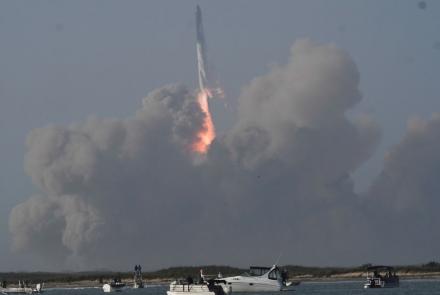(Reuters) - Elon Musk's SpaceX on Thursday launched its next-generation Starship cruise vessel for the first time atop the company's powerful new Super Heavy rocket, but the uncrewed test flight ended minutes later with the vehicle exploding in the sky.
While the two-stage rocket ship failed to make it beyond an altitude of 20 miles (32 km), SpaceX officials cheered the outcome for achieving the test flight's primary objective of getting the new spacecraft off the ground in what appeared to be an otherwise clean liftoff.
NASA chief Bill Nelson tweeted: "Congrats to @SpaceX on Starship’s first integrated flight test! Every great achievement throughout history has demanded some level of calculated risk, because with great risk comes great reward. Looking forward to all that SpaceX learns, to the next flight test — and beyond."
The two-stage rocket ship, standing taller than the Statue of Liberty at 394 feet (120 meters) high, blasted off from the company's Starbase spaceport east of Brownsville, Texas, for what SpaceX hoped, at best, would be a 90-minute debut flight into space but just shy of Earth orbit.
A live SpaceX webcast of the liftoff showed the rocket ship rising from the Gulf Coast launch tower into the morning sky over the southern tip of Texas as the Super Heavy's Raptor engines roared to life in a ball of flame and billowing clouds of exhaust and water vapor.
But less than four minutes into the flight, the upper-stage Starship failed to separate as designed from the lower-stage Super Heavy, and the combined vehicle was seen beginning to tumble end over end before exploding.
The spacecraft reached a peak altitude of nearly 20 miles (32 km) before its fiery disintegration.
A senior Federal Aviation Administration source said the spacecraft's automated flight-termination appears likely to have been activated, triggering the rocket's disintegration.
Nevertheless, SpaceX officials on the webcast hailed the feat of getting the Starship and booster rocket off the launch pad for the first time, declaring the brief episode in that sense to be a successful test flight.
A throng of SpaceX workers shown during the webcast watching a livestream together at the company's headquarters near Los Angeles cheered wildly as the rocket cleared the launch tower and again when it blew up in the sky.
SpaceX principal integration engineer John Insprucker, serving as one of the webcast commentators, said the test flight would provide a wealth of important data paving the way for the company to move ahead with additional tests.
Musk, the founder, chief executive and chief engineer of SpaceX, said on Twitter that the next Starship test launch would be "in a few months."
"Congrats @SpaceX team on an exciting test launch of Starship! Learned a lot for next test launch in a few months," he tweeted. Musk, who purchased Twitter last year for $44 billion, is also CEO of electric carmaker Tesla Inc.
Beyond the launch itself, the test mission fell short of reaching several other objectives, such as deploying the Starship vessel into space and reentering Earth's atmosphere 60 miles (97 km) off a Hawaiian coast at hypersonic speeds, where it would have faced key aerodynamic forces and blazing heat before plunging into the Pacific.
Still, getting the newly combined Starship and booster rocket off the ground for the first time represented a key milestone in SpaceX's ambition of sending astronauts back to the moon and ultimately on to Mars, as a major partner in NASA's newly inaugurated human spaceflight program, Artemis.


Comment this post